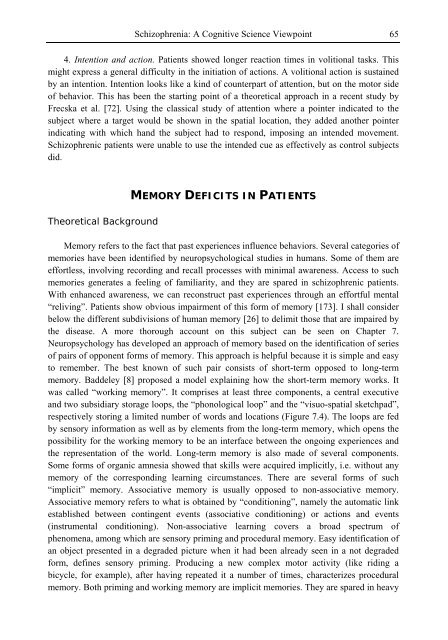Schizophrenia Research Trends
Schizophrenia Research Trends
Schizophrenia Research Trends
- No tags were found...
Create successful ePaper yourself
Turn your PDF publications into a flip-book with our unique Google optimized e-Paper software.
<strong>Schizophrenia</strong>: A Cognitive Science Viewpoint 654. Intention and action. Patients showed longer reaction times in volitional tasks. Thismight express a general difficulty in the initiation of actions. A volitional action is sustainedby an intention. Intention looks like a kind of counterpart of attention, but on the motor sideof behavior. This has been the starting point of a theoretical approach in a recent study byFrecska et al. [72]. Using the classical study of attention where a pointer indicated to thesubject where a target would be shown in the spatial location, they added another pointerindicating with which hand the subject had to respond, imposing an intended movement.Schizophrenic patients were unable to use the intended cue as effectively as control subjectsdid.Theoretical BackgroundMEMORY DEFICITS IN PATIENTSMemory refers to the fact that past experiences influence behaviors. Several categories ofmemories have been identified by neuropsychological studies in humans. Some of them areeffortless, involving recording and recall processes with minimal awareness. Access to suchmemories generates a feeling of familiarity, and they are spared in schizophrenic patients.With enhanced awareness, we can reconstruct past experiences through an effortful mental“reliving”. Patients show obvious impairment of this form of memory [173]. I shall considerbelow the different subdivisions of human memory [26] to delimit those that are impaired bythe disease. A more thorough account on this subject can be seen on Chapter 7.Neuropsychology has developed an approach of memory based on the identification of seriesof pairs of opponent forms of memory. This approach is helpful because it is simple and easyto remember. The best known of such pair consists of short-term opposed to long-termmemory. Baddeley [8] proposed a model explaining how the short-term memory works. Itwas called “working memory”. It comprises at least three components, a central executiveand two subsidiary storage loops, the “phonological loop” and the “visuo-spatial sketchpad”,respectively storing a limited number of words and locations (Figure 7.4). The loops are fedby sensory information as well as by elements from the long-term memory, which opens thepossibility for the working memory to be an interface between the ongoing experiences andthe representation of the world. Long-term memory is also made of several components.Some forms of organic amnesia showed that skills were acquired implicitly, i.e. without anymemory of the corresponding learning circumstances. There are several forms of such“implicit” memory. Associative memory is usually opposed to non-associative memory.Associative memory refers to what is obtained by “conditioning”, namely the automatic linkestablished between contingent events (associative conditioning) or actions and events(instrumental conditioning). Non-associative learning covers a broad spectrum ofphenomena, among which are sensory priming and procedural memory. Easy identification ofan object presented in a degraded picture when it had been already seen in a not degradedform, defines sensory priming. Producing a new complex motor activity (like riding abicycle, for example), after having repeated it a number of times, characterizes proceduralmemory. Both priming and working memory are implicit memories. They are spared in heavy
















